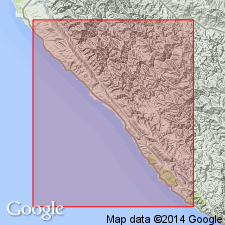
- Usage in publication:
-
- Iversen basalt
- Modifications:
-
- Original reference
- Dominant lithology:
-
- Basalt
- Sandstone
- AAPG geologic province:
-
- Northern Coast Range province
Summary:
Pg. 4, 17-18, pl. 2. Iversen basalt. Dark-gray to black dense fine-grained basalt with alternating flows of vesicular and amygdaloidal rock and intercalated lense-like masses of tuffaceous sandstone; pillow structure. Thickness 800 feet. [This part of description is identical with initial description given of unit termed Skooner Gulch basalt by Weaver, 1943. In 1944, Weaver redescribed the Skooner Gulch as a sandstone formation.] Lavas stand at high angles with prevailing northwestward dip. Rests unconformably upon sandstone and shales of Gualala group and lies with erosional unconformity below Oligocene(?) or lower Miooene sediments. Stratigraphic table shows basalt underlying redescribed Skooner Gulch formation. Age is "between late Cretaceous and Oligocene."
Type locality not stated. Exposed in sea cliffs, highway cuts, and in outcrops on hill slopes within an area approx. 100 ft wide by 3 mi long and extending from near Iversen Point northward to and beyond mouth of Skooner Gulch, Mendocino Co., northern CA.
Source: US geologic names lexicon (USGS Bull. 1200, p. 1895).
For more information, please contact Nancy Stamm, Geologic Names Committee Secretary.
Asterisk (*) indicates published by U.S. Geological Survey authors.
"No current usage" (†) implies that a name has been abandoned or has fallen into disuse. Former usage and, if known, replacement name given in parentheses ( ).
Slash (/) indicates name conflicts with nomenclatural guidelines (CSN, 1933; ACSN, 1961, 1970; NACSN, 1983, 2005, 2021). May be explained within brackets ([ ]).

